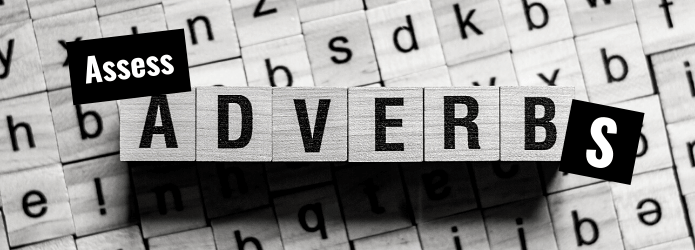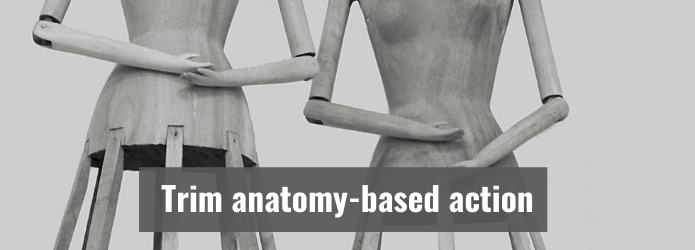|
Give your novel a sentence-level workout. Here are 6 common problems, and the solutions that will improve the flow of your fiction and make the prose pop.
Review your novel for 6 common problems. None involve major rewriting, just relatively gentle recasts that will improve your prose significantly, and make your reader's experience more immersive. 1. Assess invasive adverbs 2. Remove redundant filter words 3. Take the spotlight off speech tags 4. Pick up dropped viewpoint 5. Trim anatomy-based action 6. Turn intention into action 1. Assess invasive adverbs
Not all adverbs and adverbial phrases are bad. Suddenly, slightly, slowly, nervously, calmly, quietly can be effective if used now and then.
However, overuse is often a symptom of an author telling us what’s already been shown, which means the adverbs are repetitive and cluttering. In the two examples that follow, they can be ditched because 'fidgeted' shows the nervousness, and the apology in the dialogue shows the regret.
EXAMPLES
Even when adverbs are telling us something new, consider elegant recasts that use stronger verbs but still keep readers in the moment.
EXAMPLES
2. Remove redundant filter words
When readers are told of doing being done by a viewpoint character, filtering is in play. Realized, knew that, wondered, thought, saw, and decided are just a few examples.
The reader is already experiencing the story through a viewpoint character. For that reason, we often don’t need to be told that they realize, see, think or feel anything. We’re already in their heads. It’s telling what’s already been shown.
EXAMPLES
Filtering pulls us out of the deep, limited viewpoint. Worse, it’s repetitive and obvious. Jane has already looked at the screen so we know her eyes are doing the work; telling us that she saw as a result of her glancing is redundant. In the example where Matthew’s the narrative viewpoint character, we needn’t be told he feels the thumping in his temples, since if he weren’t feeling it he couldn’t report it. Nor do we need to know he’s thinking about that third glass because we’re already in his head. 3. Take the spotlight off speech tags
'Said' is almost invisible when it comes to dialogue tags. A smattering of 'asked', 'replied', 'whispered', and 'yelled' can also work well.
Sometimes tags aren’t even necessary because it’s obvious who’s speaking. Other times, we can replace a tag with an action beat than conveys movement and emotion. Readers should be focused on the dialogue. If a showy tag is necessary to convey a character’s voice or mood, the speech might need a rethink. In the examples below, the speech tags do the following:
EXAMPLES
ALTERNATIVES
4. Pick up dropped viewpoint
Narrative viewpoint is a big topic so I’ve focused on two common sentence-level slips:
The viewpoint character reports what they can’t know Reporting what can’t be known often comes with filter phrases such as 'could tell (that)' and 'knew (that)'. In this example, John is the viewpoint character. We experience the story though his senses.
EXAMPLE
There, behind the desk, sat Reja, the girl he’d dated two decades earlier. ‘Sergeant John Davis,’ he said, and held out his hand. He could tell she didn’t remember him. Actually he can’t tell any such thing. It might seem that way, but for all John knows, she could be hiding it because she has another agenda. Telling us that’s not the case removes any underlying suspense – stops us asking the question. This might seem like a small slip but it’s the kind of thing that turns over all the power of a limited/deep viewpoint to an all-knowing narrator and rips apart the tight psychic distance between reader and the viewpoint character. Here are two recasts that avoid the viewpoint drop:
ALTERNATIVES
There, behind the desk, sat Reja, the girl he’d dated two decades earlier. ‘Sergeant John Davis,’ he said, and held out his hand. She showed no sign of recognizing him. There, behind the desk, sat Reja, the girl he’d dated two decades earlier. ‘Sergeant John Davis,’ he said, and held out his hand. There was no recognition on her face. Non-viewpoint characters’ internal experiences Here we’re talking about head-hopping. It’s when readers are able to access emotions, mood and thoughts of a non-viewpoint character. In the example that follows, Reja is the viewpoint character.
EXAMPLE
Bloody fool. Who did he think he was? Reja jammed her hat down over her ears. No way was she leaving with him. John could have kicked himself. He shouldn’t have come on that strong. Not after what she’d been through. The solution is to recast the text so that these emotions, mood and thoughts can be inferred or accessed externally – for example, through movement or speech – by the viewpoint character only. Here’s a possible recast.
ALTERNATIVE
Bloody fool. Who did he think he was? Reja jammed her hat down over her ears. No way was she leaving with him. John palmed his forehead and spluttered an apology. ‘I shouldn’t have asked. Not after … well, you know.’ 5. Trim anatomy-based action
Prose is more immersive when readers aren’t told what they can assume is being done by body parts that are associated with particular actions – holding with hands, gazing with eyes, standing to their feet, kneeling on their knees, nodding heads, and shrugging shoulders.
In the example below, we might remove the obvious body parts and focus more specifically on the part of John's legs doing the kicking and the impact of his action. As for the gun-toter, the hands have been ditched.
EXAMPLE
John kicked out with his legs. The woman stumbled, righted herself and came at him again, pistol raised in her hands. ALTERNATIVE John kicked out, slamming his heel into her kneecap. The woman stumbled, righted herself and came at him again, pistol raised. 6. Turn intention into action
Sometimes the reader needs to know what a character wants to achieve from a particular action. This is about the why of an action.
EXAMPLE
Jane squeezed the detergent into the porridge. Just a couple of squirts to give Alice a taste of her own medicine. However, when an author means to show the how of an action but tells of intention to act, there’s a problem. The red flag to watch out for is 'to'. We can check whether the focus is on point by asking a question: What action do we want to show the reader (via Jane)? If we want to show the reader that Jane can lift her wrist – because that’s what the first example below is showing us – we can leave as is. However, that's rather dull; it's more likely that we want to show that Jane is checking the time, and so a leaner alternative is more effective.
EXAMPLE
Jane lifted her wrist to look at her watch. Bang on two. ALTERNATIVE Jane checked her wristwatch. Bang on two. Summing up
None of these 6 tweaks are rules! Think of them instead as suggestions to consider, ideas that can help you smooth and tighten up your prose.
And don't worry about them at first-draft stage. Use that space to get the words on the page. Put your sentence-level editing craft in play with a later draft, and once your story's structure, plot and characterization have been fully developed. Further reading
Want to develop your line-editing skills? Check out these resources:
Louise Harnby is a line editor, copyeditor and proofreader who specializes in working with crime, mystery, suspense and thriller writers.
She is an Advanced Professional Member of the Chartered Institute of Editing and Proofreading (CIEP), a member of ACES, a Partner Member of The Alliance of Independent Authors (ALLi), and co-hosts The Editing Podcast. FIND OUT MORE > Get in touch: Louise Harnby | Fiction Editor & Proofreader > Connect: Twitter at @LouiseHarnby, Facebook and LinkedIn > Learn: Books and courses > Discover: Resources for authors and editors
0 Comments
Leave a Reply. |
BLOG ALERTSIf you'd like me to email you when a new blog post is available, sign up for blog alerts!
TESTIMONIALSDare Rogers'Louise uses her expertise to hone a story until it's razor sharp, while still allowing the author’s voice to remain dominant.'Jeff Carson'I wholeheartedly recommend her services ... Just don’t hire her when I need her.'J B Turner'Sincere thanks for a beautiful and elegant piece of work. First class.'Ayshe Gemedzhy'What makes her stand out and shine is her ability to immerse herself in your story.'Salt Publishing'A million thanks – your mark-up is perfect, as always.'CATEGORIES
All
ARCHIVES
July 2024
|
|
|
|























 RSS Feed
RSS Feed





